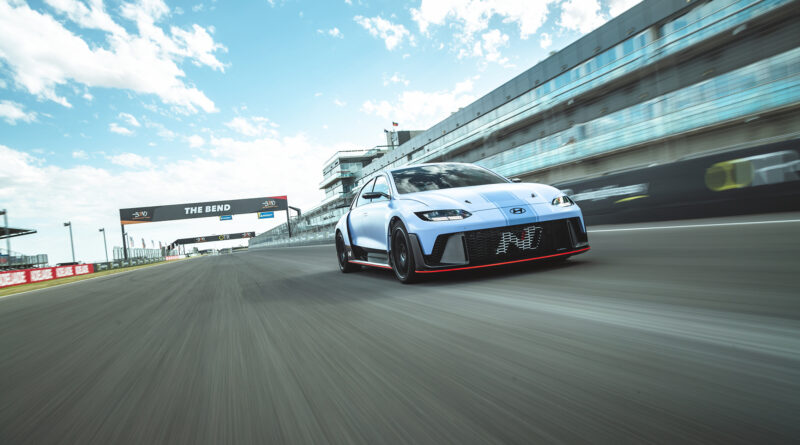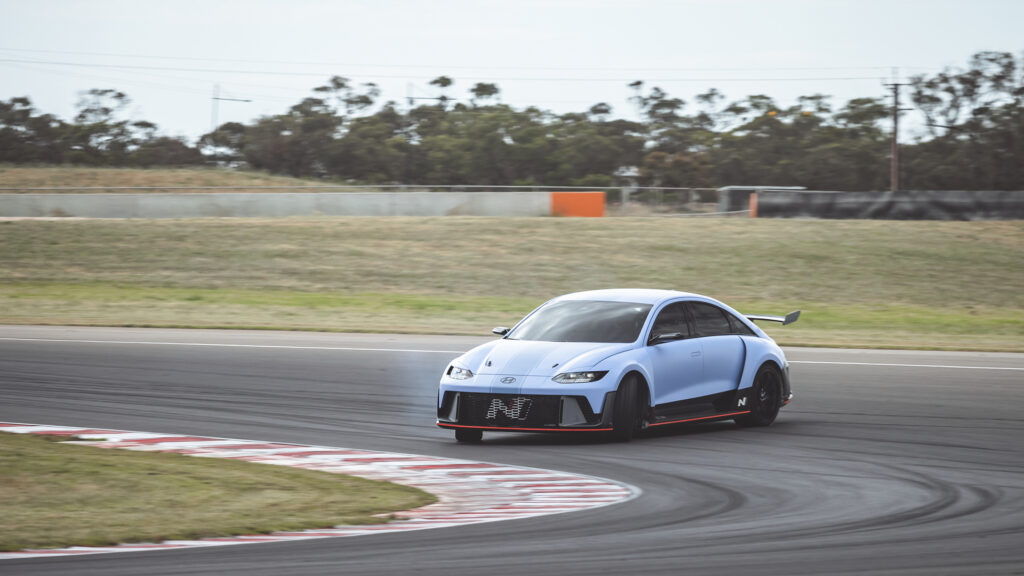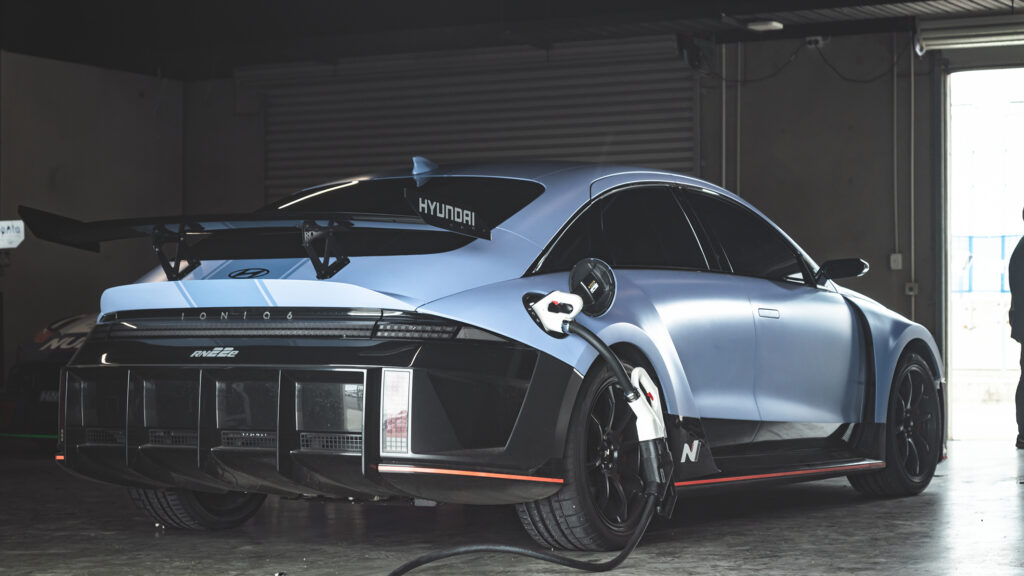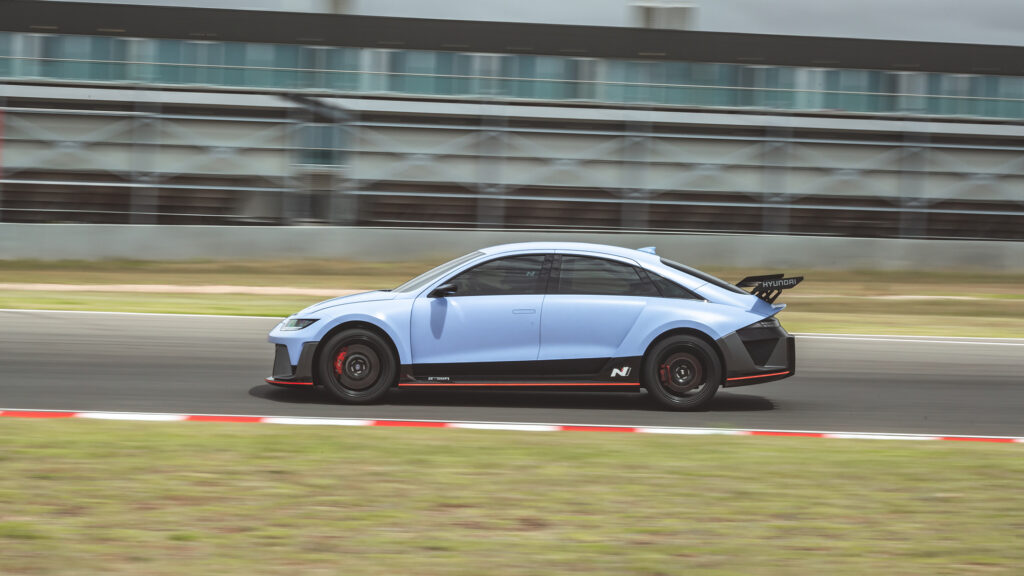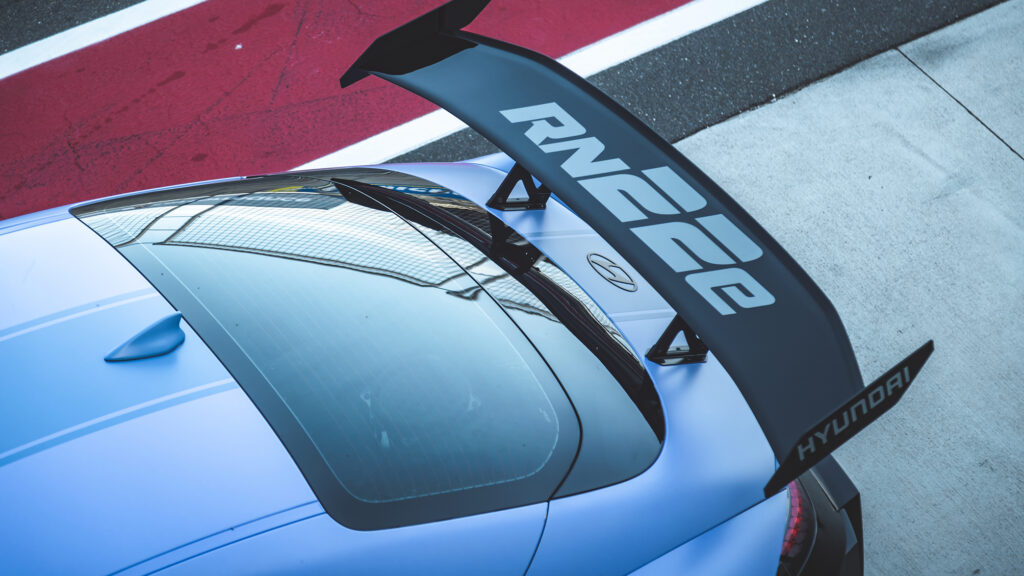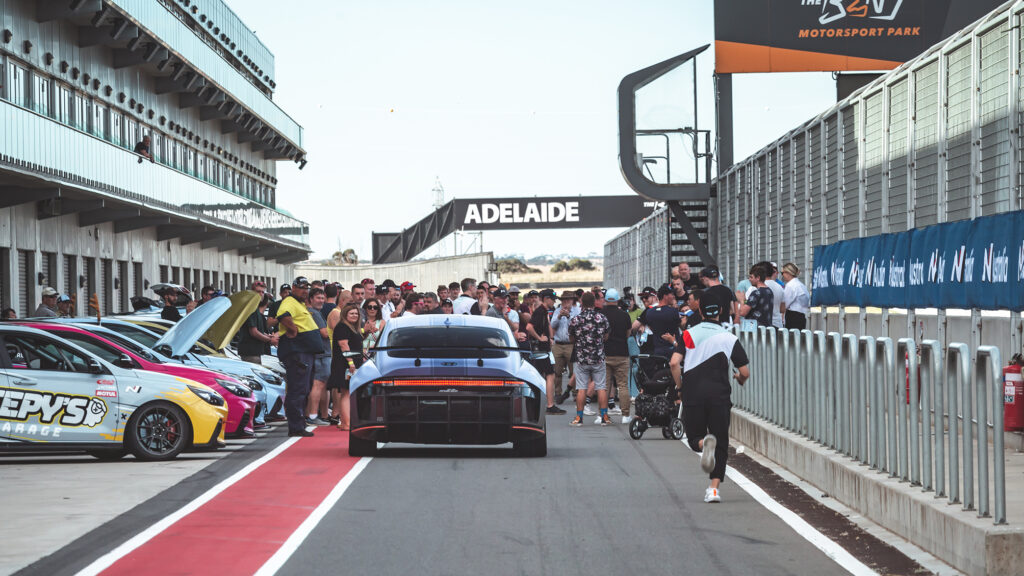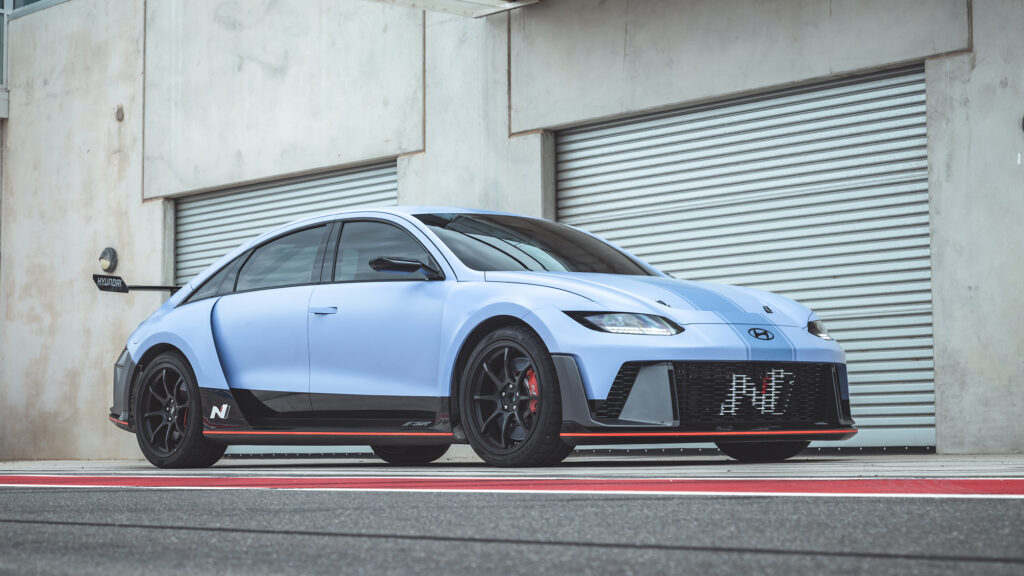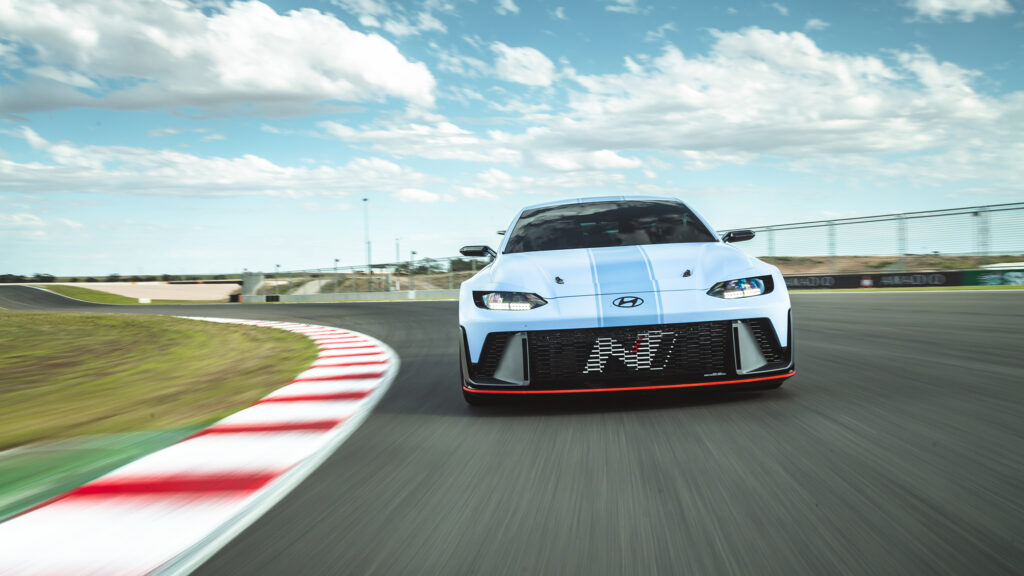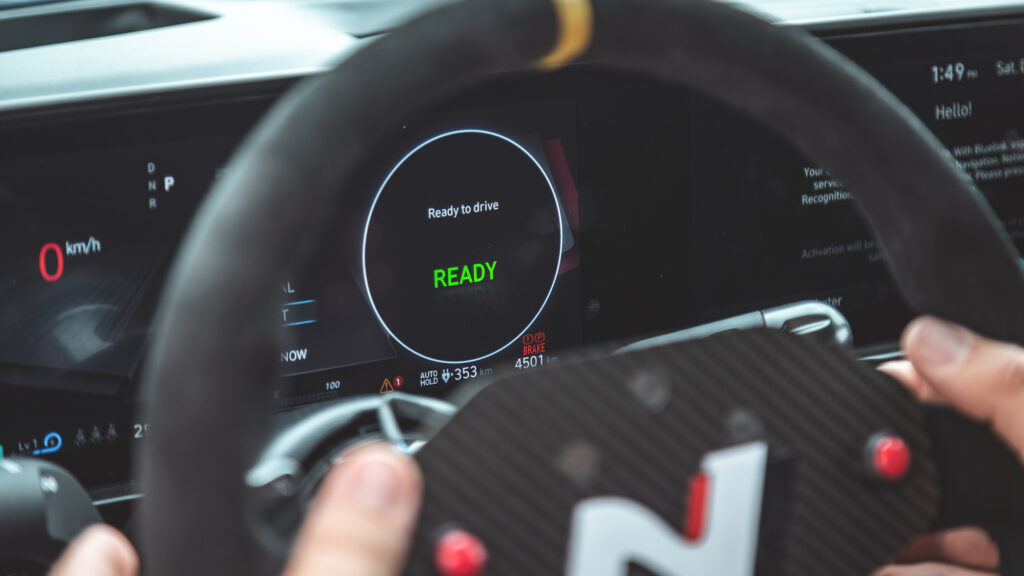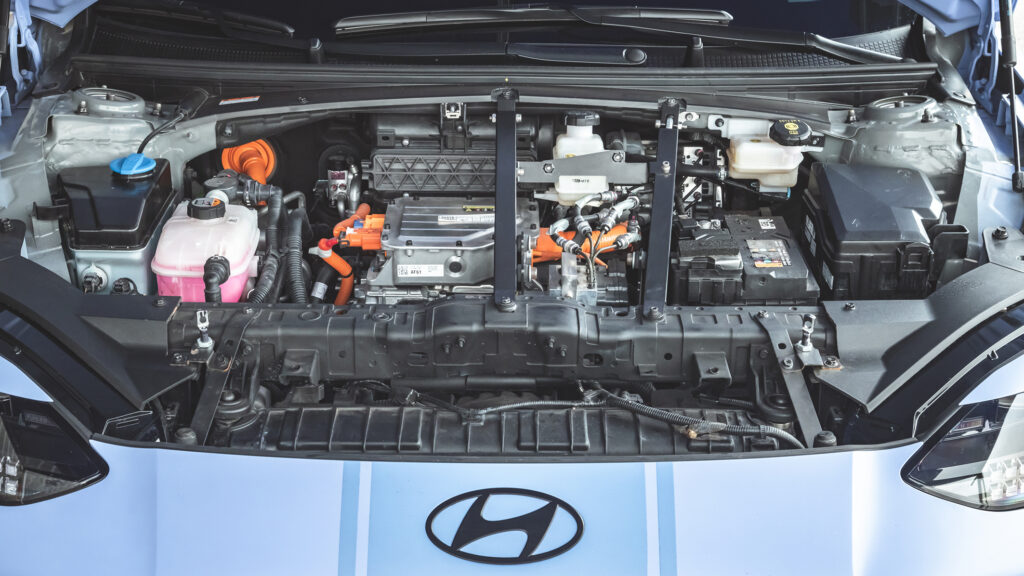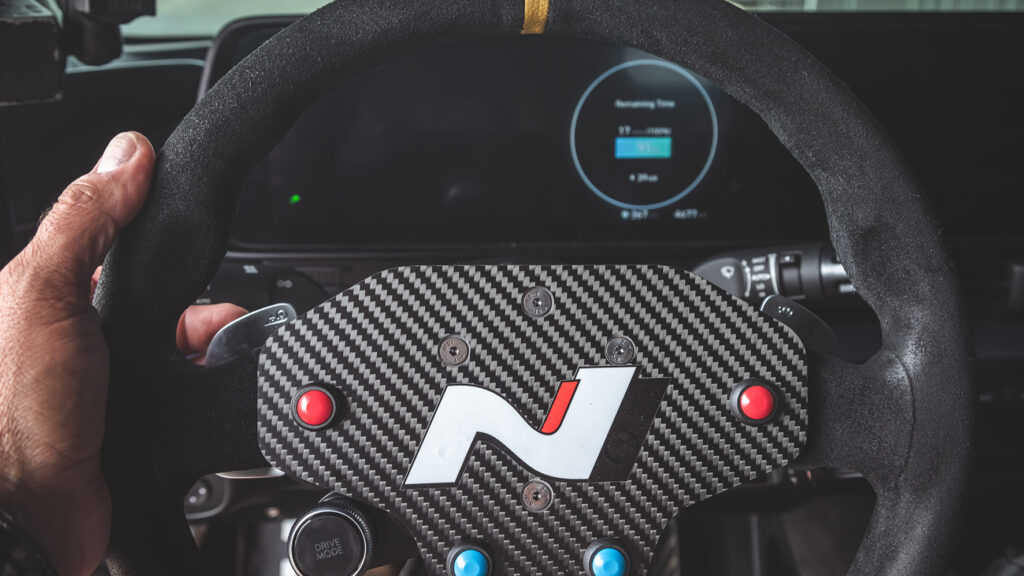Track test: Hyundai’s incredible RN22e EV
I’m harnessed into a race seat, there’s a low rumble sounding somewhere between a turbo four-cylinder and V8, and paddles behind my Alcantara steering wheel are apparently shifting through gears.
So far, so normal. Well, only if this race car trundling along The Bend’s pit lane is gulping down Super and I’m swapping cogs through a proper mechanical dual-clutch auto.
But all is not as it seems. This is Hyundai’s RN22e prototype, a full-blown electric vehicle with aero-enhanced Ioniq 6 body and a range of tricks and treats to seemingly do the impossible: offer proper driver involvement in an EV.
Some insist drivers already enjoy plenty of engagement, fun and thrills in an electric car. And in some ways they do.
Many are dazzlingly fast in a straight line – proper sub-3 seconds to 100km/h stuff – and their low centre of gravity and impressive chassis tunes (see the Porsche Taycan and Tesla Model 3 Performance for evidence) can bring physics-defying cornering.
Thing is, there’s very little for the driver to do. It’s very much point and press, have your head pinned into the seat and turn the wheel when a corner arrives. There’s no satisfying shifting between gears, no listening and feeling revs rise and fall, and certainly no soulful combustion engine sound.

Credit to Hyundai, it’s been searching for ways to fun-up our EV driving future. The brand’s performance ‘N’ division didn’t want to put its name to any vehicle not adhering to its principles: the car must be a “corner rascal”, have racetrack capability and remain a sportscar able to be used every day.
No easy task, but imperative ahead of Hyundai slinging the ‘N’ badge on the Ioniq 5 N, set for production in August 2023 and in Australian showrooms not long after, probably for around $100,000. The E-GMP-platform RN22e give the strongest hints yet of what we can expect from the production model.
True track talents
Best to explain the results to you first.
Needless to say our track time was short – just four laps of The Bend’s magnificent circuit – and due care was required in this ‘don’t dare bend it’ mobile lab.
Once out of pit lane and on track I squeeze the throttle and Bang! No complaints on the acceleration front. There’s 430kW and 740Nm on tap from the brace of electric motors (as we’ll find in the Ioniq 5 N), top speed has been upped to a racetrack-suited 260km/h, and 0-100km/h is dealt with in under four seconds.

Now for that corner rascal bit. Hyundai’s introduced a twin-clutch type rear differential called an e-TVTC, so it can “explore torque vectoring by twin clutch.” This means optimised torque distribution in different drive modes for this all-wheel-drive EV, altering how much torque is sent to the front and rear wheels.
Up to 100 percent can go to an individual rear wheel… and it all means skiddy fun on tap. As we see with many performance cars these days, a Drift Mode is offered. With plenty of track traffic (and that priceless prototype problem) we thought better of trying it, but Hyundai’s factory race drivers were happy to show the RN22e’s drifting potential. Good news was it proved smokey, sideways and spectacular.
Buyers may have to wait until the production Ioniq 6 N arrives to snare the e-TVTC, as the Ioniq 5 N will be fitted with an e-LSD as used in the Kia EV6 GT. Electronic adjustable dampers and lowered suspension (only by 10-15mm to protect the battery) are also expected on the production Ioniq 5 N, as is a drift mode.
Back to the RN22e. It really does sit wonderfully flat in the turns, steering response is lightning quick and the rear end is deliciously playful. Come off the throttle mid-corner and the back end rotates, then treat yourself to plenty of throttle coming out of the turns and there’s more oversteer fun. It’s a playful thing, that’s for sure.
Best of all, and despite the rarity of this prototype, it’s an easy and forgiving thing to drive quickly and confidently. Unlike many race cars I’ve sampled, the RN22e always felt like it was on my side, never slinging out its rear before first giving plenty of warning.
Take things easier and more accurately and it’ll change direction with lovely balance while feeling properly quick in corners, smartly helped by the regen braking when off throttle. And by God the way speed builds once through the apex is like a video game. Those i30Ns and i20Ns we were sharing the track with? We flew past them. Yes, a proper corner rascal.
An EV with paddle shift?
I pull back on the two steering wheel paddles to engage Sport Mode. This means the N e-shift’s in play, allowing those simulated gear shifts. The motor noise builds and you tap your way through ‘gears’ just like a real dual clutch auto, with drops in power and a little jolt for good measure.
It certainly adds driver engagement – you feel more part of the performance rather than just watching from the wings. Downshifts coming into a corner – with the simulated engine braking – mean you feel more involved than just stomping on a brake pedal. But they’re not quite right, those gear shifts. Ace engineer Albert Biermann, technical adviser to Hyundai N, even acknowledges so.

There’s no fake ‘bouncing off the limiter’ to help time the up-shifts, and in a crash helmet it’s hard to hear the cosmic engine sound stretching to a point where you should move up a cog.
Fear not, Biermann says, the Ioniq 5 N’s system is already streets ahead of the RN22e’s effort. More evolved, more involving… and with a better sound too.
As thrilling as this track drive was proving, an element every EV struggles to overcome is sheer weight. The RN22e – much like the Ioniq 5 N – is lumbered with almost half a tonne of battery mass.
Total vehicle weight is well over two tonnes, and that can’t be disguised on a track. I found the same issue with the otherwise brilliant Porsche Taycan GTS on a circuit. This aero-clad Hyundai feels far more agile than it deserves to do, considering its lardiness, but don’t go trading your Caterham in just yet.
Hyundai’s given the RN22e 400mm front brake rotors clamped by four-piston callipers. They do a mighty job of hauling the EV to a stop – helped by regen braking – but they work seriously hard.
Track charging
Now, the issue of battery life.
We were given about 10 minutes on track, as was another journalist following us, then the prototype was plugged in. We’d not used much battery, but when charge gets too low or batteries and components too hot, the car limits performance for protection.
Hyundai’s battery can charge from 10-80 percent in under 18 minutes: if there’s an ultra-rapid 350kW charger to hand. For now, you’ll not find one of those at a race track.
A 20 minute stint at a track isn’t too bad at all; I’d do similar in a petrol performance car before giving its brakes, tyres and driver a decent rest.
Biermann said they’ve managed to get the prototype Ioniq 5 N working at peak capacity for two laps of the Nurburgring Nordschleife. And that’s with its gun test drivers piloting it at ten tenths, not we wannabe amateurs. Again, we’re promised better cooling and tech will improve things further down the track.

Overall, there’s no disguising the fakery at play here. The noise, the gear shifts, the jolts and the clever electrics aiding sidewaysness in corners.
But Hyundai isn’t pretending this car is something it’s not. The N team say it has the challenge of making EVs more engaging to drive, and will do what it can to help. If that means simulating certain elements to be more like the petrol performance cars we love, then so be it. And they’ve done a bloody good job of it for a first effort.
And you know things can only improve. We’ll probably get more accustomed to the artifice; the tech will improve and other ways will be found to make these EVs more enjoyable and enduring at the limit.
If the Ioniq 5 N is to be even more engaging and finessed than this RN22e, we enthusiast drivers have plenty to look forward to. It may not be a comparable replacement for a proper petrol track car, but it’ll bring its own electric twist to trackday fun.
This driver’s grin after a few laps? Nothing fake about that at all.

